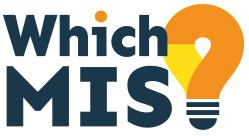Last week we posted an article on finance systems within an MIS. In this post we look at reporting and analytics functionality, and specifically about the use of AI.
If you are thinking of changing your MIS, it is worth checking the various considerations that are needed to be made.
This is the link to our own ‘Considerations‘ blog where you can also download our free document outlining the steps to take.
The DfE also provide some guidance which you can access here.

All MIS must include some reporting, but not all systems are equal. As a rough guide:
Basic Requirements:
- Simple Reports: These should be menu-based and pre-defined for users. For instance, straightforward attendance or grade reports should be readily accessible.
- Intermediate Complexity Reports: These should be menu-driven or utilize “wizards” to allow most users to create them with minimal training. Examples include class performance summaries or behaviour reports.
- Complex Reports: The system should offer a way to develop complex reports through a simple programming interface.
Desirable Features (“Nice to Haves”):
- Regulatory Compliance: The MIS should adhere to data protection regulations, including GDPR. Compliance with census returns, safeguarding, and central records is crucial.
- User-Friendly Interface: An intuitive and user-friendly interface simplifies report generation and reduces staff workload.
- Integration with Other Systems: The MIS should seamlessly integrate with other educational systems (e.g., finance, assessment, and communication platforms).
- Customizable Templates: Schools appreciate the ability to create custom report templates based on their specific needs.
- Automated Scheduling: The system should allow automated report generation and distribution at specified intervals (e.g., weekly, monthly).
- Data Visualization: Visual representations (charts, graphs) enhance the clarity of reports.
- Parent and Student Portals: Providing access to reports for parents and students fosters transparency and engagement.
- Real-Time Data: Timely access to up-to-date information is essential for effective decision-making.
- Support for Multiple Devices: Compatibility with various devices (computers, tablets, smartphones) ensures accessibility.
- Data Cleansing Tools: Features to clean and validate data improve report accuracy.
AI’s Role in School MIS Systems:
Generative AI, including large language models can play a significant role in MIS systems:
- Efficient Reporting: AI chatbots can quickly analyse, structure, and generate text-based reports, reducing staff workload.
- Prompt-Based Responses: AI tools can answer questions, complete tasks, and respond to prompts in a human-like manner.
- Content Creation: AI-generated content can include audio, video, and images.
- Subject Knowledge Enhancement: AI complements human expertise by providing quick answers and automating routine tasks.
- DfE policy paper in generative AI in education
We asked all MIS providers to let us know if they offer reporting and analytics, and if so, could they let us have a paragraph or two on each element you offer. Below are the responses received to date, in the MIS provider’s own words:
As usual, we have listed the MIS responses in alphabetical order.

Arbor has a built-in, native analytics that can help schools, MATs, LAs and Governments track performance in real-time. Every data-point is able to be reported on in-system or linked live to excel, sheets, powerBI or Looker for more custom analysis.
Arbor’s MAT MIS also allows each Trust to have their own data warehouse where they can see their MIS data alongside DfE, Ofsted, safeguarding, budget, HR and governance data to get a holistic view of performance in one place, with live national averages to see your schools’ performance in context.
Ask Arbor is our AI assistant which currently allows schools to draft personalised communications in any language, cleverly merging in data from Arbor. It can also write an instant student report, blending qualitative information from teachers with all the data in Arbor to create a highly personal report!
Finally, Arbor turns everyone into a data analyst by allowing you to query your data in Arbor using natural language, like “give me a report on Gary Smiths’ attendance last week” and Arbor will build the report for you. More than this, Arbor reduces time from identification to intervention by allowing you ask it to “write me an email to Gary Smith’s parents asking them to come in at 4:30 and book me a free room for the meeting”. We think this will transform the way schools look at and act on their data, saving days or weeks of time and effort.

Bromcom MIS conforms to all of the DfE’s statutory data collection requirements. It provides the tools to create school returns easily, including spring, autumn and staff workforce census. For MATs and LAs, this also means a central overview, with the ability to intervene at school level.
Bromcom offers a wide range of live data dashboards, which present data and KPIs in an easy-to-read screen. Users can monitor Attendance, Behaviour, KS4, KS5 or Safeguarding data for the entire school or specific cohorts, with the ability to compare against past benchmarks, and export into Excel. MATs and LAs can take advantage of Bromcom’s ‘eye in the sky’ tool, Vision, to connect with and oversee all their respective academies or maintained schools.
A selection of schools can easily be made to drill down into, or run analytics to identify how schools are performing.
In 2023, Bromcom became the first MIS to incorporate the power of artificial intelligence (AI), a groundbreaking feature which helps with lesson planning, parent communications, and general queries. Future developments will transform the ways in which schools can analyse their own data and generate insights, ultimately supporting better student outcomes.

In D6, the data from the school’s MIS is translated into school health reports that stakeholders can use to assess school performance in terms of Learner and Teaching Health, Behaviour and Social Health, Leadership and Management, Financial Health, Parents and Community Health, and Overview of School(s) Health.
These dashboards are also very useful for Multi-School/MATS to use to amalgamate and assess school performance data to mitigate risks and identify opportunities. Multi-School/MATS can also use our Communication solution to communicate with their schools and stakeholders.

PowerSchool Analytics and Insights provides educators with an end-to-end solution with analytics, data visualization and embedded tools and workflows all in one to enable data-driven decision making across an entire organization.
PowerSchool Analytics and Insights brings together critical source system data to turn valuable insights, trends, patterns, and fluctuations into student development and educational outcomes.
Educators can then more easily track student, school, and organizational performance to simplify instructional, talent, and operational decisions made at any level.
Predictive risk analysis is also available to provide early warnings based on educator-controlled AI/ML models.
Having all of this data in one place is also a recommended first step for leveraging PowerSchool AI to ensure that the generative-AI recommendations are based on a comprehensive view of all school data.

Available now: SIMS Group Analytics for strategic performance monitoring
SIMS Group Analytics is a comprehensive reporting and analytics service tailored for MATs and school groups using SIMS.
It provides a holistic view of group or trust performance, so leaders and administrators can identify trends, benchmark against MAT and national averages, and deploy targeted improvement strategies.
Pre-defined performance dashboards give MAT leaders critical data on attendance, demographics, conduct, staff, and statutory assessment giving them the insights they need for efficient, well-informed decision making. These dashboards can also be configured to a MAT’s specific needs with the support of one of the SIMS education consultants.
MAT’s also benefit from personalised support and guidance from our consultants with 6 hours support included in the first year to help configure their set up and be on hand to answer any queries.
Coming this autumn: SIMS Group Hub – a central hub for leaders to access, manage and share data across their schools
As of this autumn, SIMS Group Hub users will have a central login to view performance in a centralised location across their schools – providing that crucial holistic MAT or group overview to support growth and scalability.
Users can customise their schools overview list, ensuring essential school-level information (such as school phase, Ofsted ratings and pupil demographics) is easily accessible in a structured table format. Additionally, MAT users will be able to set up pupil attendance targets for the entire trust or individual schools in the upcoming academic year.
Group Hub functionality will be expanded to include the ability to view detailed staff profiles across the trust from a single location. Other areas of group control will include the ability to combine your schools to analyse and compare key data, with the ability to drill down on the school, pupil or staff member for deeper insights.
Future releases will give MAT leaders the ability to:
- Set targets and KPIs to track group and individual school progress
- Push policies to schools ensuring consistency and compliancy across the group
- Integrate with FMS and FMS Reporting
- Integrate with HR systems
Seamless integration for informed decision-making
SIMS Group Analytics and Group Hub will work seamlessly side-by-side, giving MAT leaders a single view of key data insights. This holistic whole-school view will allow MATs to make decisions at group level, deploy these efficiently across all schools, and then consistently collect that data to track performance.

